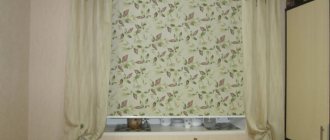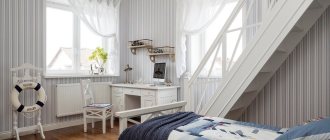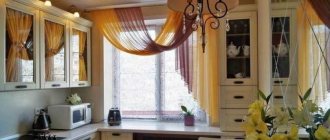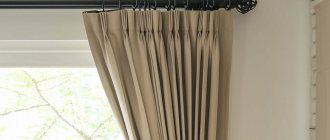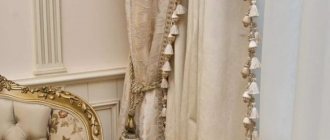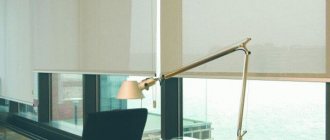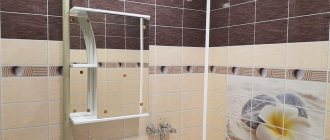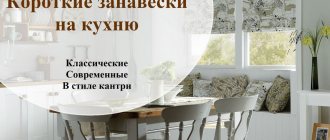A variety of curtains, curtains, tulles and drapes are decorative elements that no interior can do without. Some of them are simple and inconspicuous, while others have complex designs and bright ornate designs with many decorations and accessories. One of the most popular and effective of them is curtain tassels, which can transform even the most ordinary-looking fabric into a stylish element of room decoration.
Mounting features
Thread fringes are popular and available in a wide variety. They come in different widths or colors. They are sewn on without any problems, even a school-age girl can do it.
Fringe decoration decorates windows and doors; it is also used for other elements of interior decor - it can be successfully matched to tablecloths, bedspreads, pillows, and toys.
It is more difficult to hang fringe that combines threads with other materials. There are also nuances depending on where the decorations are attached - the bottom, sides or top of the canvas in the form of a complex draped lambrequin. You need to consider how the jewelry will look after attaching.
Tieback color
The color scheme of the tiebacks, like them themselves, can be very different. The tiebacks can be made to match the color of the curtain, then they will serve only a functional purpose - to hold the curtain.
Contrasting tiebacks are made from partner curtain fabric, or any other fabric that matches the color. In the kitchen, the scoop can be made in the same color as the tablecloth and potholders, or other bright kitchen utensils. For a child's room, interior elements in pink, soft lilac, if this is a girl's room, tones are suitable.
Tiebacks using gold thread, with fringe and tassels are very formal and would be more suitable for decorating a living room in the appropriate style.
Examples of decorating curtains
The combination of fabric with bamboo, plastic, wooden elements, tassels, pompoms, and bells is gaining popularity. The main thing is not to overdo it with decorations, so that everything together does not turn into a rough, vulgar heap. The first rule is to select weightless decorations for thin openwork curtains, and heavy ones for massive curtains.
What to pay attention to when choosing
In principle, fringe for curtains is appropriate in any room; it is a worthy decoration for home and office. Such curtains catch the eye and immediately form a favorable impression of the owner.
However, when choosing, pay attention to the color of the curtains, texture and density of the material. Gold or silver braid matches almost any expensive curtain fabric.
Large decorative elements suit massive, heavy curtains. And for airy curtains, elegant, subtle decorations are more suitable.
Pickups in different rooms
Tiebacks can be used to decorate windows in the living room, nursery, kitchen, and bedroom.
Tiebacks for the living room
This room is assigned a representative function. To add sophistication to the decor, light tulle is decorated with magnetic holders, and curtains are decorated with heavy tassels made of silver-plated cords.
Wooden, leather, fur, and fabric models with rhinestones, sequins, and beads would also be appropriate in the hall.
Tiebacks for children's
When decorating a window in a nursery, preference is usually given to various soft toys. Bows, ruffles, and beads are also welcome. Such decor will delight the eyes of both adults and children.
Safety is of great importance, including from an environmental point of view. It is also important to consider the child’s interests and hobbies.
Kitchen hooks
The kitchen window is usually decorated with more airy curtains. The material chosen for them is natural, for example, linen. And it can be easily combined with all types of curtain ties.
Bedroom tiebacks
In the room for night rest it is allowed to use satin ribbons, decorative cords, and intricate bows. You should avoid excessively large accessories.
It is also worth remembering that any addition to the curtains in the bedroom should match them in color. This technique allows you to create the most harmonious composition.
When choosing holders and tiebacks for curtains, you should be guided by the existing interior style, the geometry of the room, and your own mood. The main secret is to study information about the types of such accessories before purchasing and consult with an experienced designer.
Interior decoration of rooms
The interior style plays a leading role in the choice of decorations. In design projects of modern trends you will not find heavy curtains trimmed with fringe. And this is typical for the standard oriental style or Baroque. Therefore, you need to design curtains taking into account the general principles of the chosen interior style.
Living room
Thread fringe in the living room is appropriate on curtains, lambrequins, tiebacks, and curtains. If the fringe for the curtains is also decorated with tassels, then a festive and solemn atmosphere will settle in the living room.
For the oriental style, sliding red curtains trimmed with golden fringe along the edges are traditional.
Bedroom
To make the bedroom more comfortable, the curtains in it are decorated with fringe and tassels. Only they are chosen not to be contrasting, but to match the tone of the curtain fabric.
A similar edging of the canopy above the bed is also practiced; this makes the bedroom elegant. The decor of glass bead curtains evokes motifs from oriental fairy tales.
The elite Empire style can be created by heavy fringe on velvet curtains decorated with lambrequins. A soothing blue color is suitable for the bedroom, which can be decorated with gold fringe.
Kitchen
The kitchen is different from other rooms; shortened curtains are usually hung there, which do not move apart, but rise. Roller blinds and Roman blinds are also popular in kitchens.
And all these options at the bottom can be decorated with fringe; this solution looks funny, but elegant.
You can decorate the pillows on the kitchen sofa with fringe, a tablecloth with napkins to match, this will add coziness and make the interior unified and solid.
To create a Country style in the kitchen, the fringe is additionally decorated with pompoms.
Types of grabs
If you start looking for photos of curtain tiebacks on the Internet, you will soon notice that they come in different types. Each of them has its own advantages.
Rigid and flexible
Soft fabric holders can match the shade of the curtain or contrast with it. In addition, they must be combined with the shade and design of the cornice. The shape of garters can be classic, braided, straight or cone-shaped. Based on the general style of the room, ruffles, frills and lace ties are used.
Lovers of the classics prefer symmetrical draperies.
To emphasize the original design of the curtains, they are decorated with ornaments, embroidery, beads, themed tiebacks - for decorating the kitchen, reminiscent of fruits or for a children's room - small soft toys.
Even the most inconspicuous curtains will be transformed and look stylish if you choose the right garters for them.
Among the soft types, brushes and cords decorated with glass beads, metal and plastic parts are distinguished separately. Hard models can be metal hooks or hairpins. The hooks are made in the form of a loop, which is attached to the side of the window.
Metal
They are quite an interesting solution. They can be of simple form or represent exquisite, forged works of design art.
Magnets
Models for curtains with magnets are an ideal option for attaching lightweight fabrics. Sheathed magnets (from funny plastic smiley faces to semi-precious stones) are sewn onto the ends of clips made from ribbons, decorative cables or twisted cords. The most popular magnets for curtains are metal or plastic products of simple geometric shapes (round, oval, diamond-shaped), plain, with a pattern, decorated with rhinestones or covered with fabric.
Plastic
This material is suitable for lighter fabrics. Diverse and versatile. Therefore, plastic wall holders are suitable for any interior.
Hairpins
Cloth clips made of metal, plastic or wood differ from similar hair accessories only in size. They must match the fabric in density. Light tulle curtains are best suited with small, elegant pins; curtains made of thick fabrics will need to choose large items. Hairpins are not suitable for heavy curtains; metal holders or fabric “banana” tiebacks are more appropriate here.
Tree
This classic option will be appropriate in almost every room design. But most suitable for a strict and elegant interior.
The photo shows a curtain decorated with a wooden tieback.
Leather, eco-leather
Real leather, leatherette, eco-leather are an excellent option for creating curtain holders. The appropriate texture, color, and thickness are chosen in accordance with the existing interior design. Genuine leather, even if it is just a narrow strap, can easily hold even a relatively heavy curtain. A product woven from four to six narrow strips also looks beautiful. Sewing an item on a machine is not difficult even for novice craftsmen.
With brushes
Multi-colored twisted cords with tassels are a noble status decoration. They look especially good on exquisite luxury fabrics: brocade, velvet, velor, thick silk. Draping heavy fabric with them is easy - just tie it like a belt in the right place. Often such curtains are monophonic and rich in color, and cords enliven their monotony.
To make the draperies look harmonious, the fittings must be selected in accordance with the status of the curtains. Luxurious curtains, “belted” with cheap cords, will look more than modest, and light flying curtains accompanied by heavy ropes with massive lush tassels will look tasteless.
Kanzashi
They are created using the technique of folding squares of silk fabric. As a result, unique decorations are obtained, which in turn are also used as tiebacks.
Non-standard
They can have the shape of a flower, an animal, a geometric figure, etc. For their production, wood, metal, straps, ropes, and improvised materials (lace, macrame) are used.
Bows
They look elegant and give the room good energy. They are associated with the holiday and awaken joyful memories.
Cutlery
Stylish curtain holders for the kitchen are made from ordinary cutlery: forks, spoons, cups. To make them, just bend a fork or spoon and attach them to the wall, and cut out the bottom of the cups and hang them by the handles on hooks attached to the wall. Metal devices are able to hold thick curtains. Porcelain and earthenware cups can only hold tulle with light curtains.
Beads
Beaded curtain tiebacks are suitable for plain or pale-patterned curtains in the bedroom and living room. They look elegant and create a chamber, peaceful atmosphere. To create tiebacks for curtains from beads, you can take ready-made jewelry or assemble them yourself, using not only beads, but also rhinestones, beads, all kinds of decorative chains that are in harmony in texture and color with the design of the room.
Toys
Cute toys made of felt or plush, hugging curtains - the perfect design for curtain tiebacks in a nursery. They can be draped over the fabric, holding it with long legs tied in a knot, a tail into which a wire is inserted, sewn onto a strip for curtains made of satin ribbon, attached to magnetic holders, buttons.
Another fashionable variety today - cute fairies, ballerinas, tilde dolls have become a new breath in window design not only for children's rooms, but also in living rooms, as well as when decorating windows in children's cafes.
Accessories of complex shapes, bright colors, decorated with shiny fittings are suitable for plain-dyed curtains. For curtains made of printed fabric with a complex pattern, it is better to use simple tiebacks made of the same fabric or cords with tassels.
Foamiran
Foamiran, also called EVA, plastic suede, revelour, “foam” is a soft decorative foam material used for needlework. Tiebacks made from it are usually decorated with quite realistic flowers, entire bouquets, made mainly in pastel colors. This design will fit perfectly into the interiors of classicism, shabby chic, and baroque.
Macrame
Macrame is a popular type of needlework, an applied art based on the knot weaving technique. Curtains with tiebacks made using the macrame technique look very original; they are capable of gathering dense, heavy fabric, but they also look great on light curtains with a successful design.
From scrap materials
It is not easy to list everything from which they are made. The materials used are ropes, ribbons, twine, braid, yarn, scraps of fabric, old jewelry, ties, belts, belts, candlesticks, computer disks. Even plastic bottles can be used, because they can be covered with fabric or tied. The choice depends only on the imagination of the master and on what he has at hand.
The use of improvised materials makes it possible to bring to life seemingly crazy design ideas and realize unspent creative potential. A small detail in the form of an unusual or simply beautiful holder or a bright magnetic curtain tie often becomes an accent and makes the interior special and not boring.
Curtains with glass beads
For curtains made of chiffon or organza, as well as for curtains made of light fabrics (satin, silk), fringe with beads made of light, cheap plastic, incl. transparent, imitating glass. An intermediate option in price is glass beads, which are colored glass thin short tubes that can be strung on a thread. The most expensive options for luxury interiors are made from crystal, which shimmers with all the colors of the rainbow under artificial lighting conditions.
The beads can go in a continuous row or be sewn to the thread fringe only in places. Using glass beads, you can create complex mosaic compositions or visual borders.
Decorating curtains with glass beads, rhinestones or beads looks organically in both classic and avant-garde modern interiors.
Types of curtain tassels
Many people mistakenly believe that brushes are a thing of the past and it is simply not appropriate to use them in modern decor. They are deeply mistaken!
Recently, the fashion for the well-forgotten old has begun to return. Therefore, curtains decorated with tassels are well suited to different interior styles.
Brushes can transform any room . Choosing curtains for the bedroom with such a decorative element will be very useful - the room will look more comfortable, and a festive mood will reign in the living room.
You can buy ready-made brushes or make them yourself.
To do this, you will need a thin synthetic cord and a variety of yarn in large quantities. You can decorate them as you wish with beads, beads of different sizes, glass beads, rhinestones, decorative flowers and butterflies. For those who like to follow fashion trends, curtains made of glass beads are suitable, about which you can learn more here.
You can completely fill the brush with balls , which will also look unusual and beautiful. They are made from gold-plated and silver-plated cords, ribbons and threads. To make the brush more magnificent, it can be assembled from several small ones.
Silk threads
The silky shine of the fringe will give the room a unique, cozy, festive atmosphere. It is used both for edging the edges of fabrics and for making curtain ties.
You can buy natural silk threads separately, and then crochet a lace ribbon from them yourself. Such a decoration can become a masterpiece of handicraft, a real family heirloom.
Conclusion
When choosing suitable brushes or decorative tiebacks based on them, do not forget about the functional purpose of the room. No one forbids the use of such decorative elements in the kitchen, but they must be made of practical materials and not oversaturated with details.
Elements that perform only a decorative function should not be used for tying curtains that are constantly collected and unraveled. In all other cases, brushes do not cause much trouble, bringing only aesthetic pleasure.
Place in the interior
More often, heavy curtains are decorated with fringe; in such cases, voluminous heavy braid is more appropriate. For example, the dark green velvet material of the curtains, bordered with golden fringe with tassels, looks chic.
However, airy curtains with weightless fringe sewn on, with or without additional decorations, are also very aesthetically pleasing. A narrow silver or golden fringe edge will add additional elegance to the tulle.
How to sew
Now we’ll tell you how to sew fringe to a curtain. If you think that this is a trivial matter, then you are mistaken. If you make a mistake in this matter, then expensive curtain fabric can be hopelessly ruined. The work requires patience and diligence. Most often, the sides or bottom sections of the canvas are edged. Let us describe step by step the correct algorithm of actions.
- If the fabric is synthetic, it is first burned along the edges, then the edges are folded and overcast (if possible).
- The braid is placed on the table, and the prepared edge of the curtain fabric is placed on top of it, wrong side down, with the threads under the fabric and the tape out. You should sew the fabric to the braid, stepping back a little from the edge. If the braid is wide, then a double-row stitch is made.
- The fringe is pulled out from under the fabric and straightened with threads outward. In this position, the braid along the very edge should be sewn to the front side of the fabric.
Such sewing ensures that the curtain in the place where the fringe is attached will not stretch or wrinkle, i.e. not deformed.
How to make it yourself
Not everyone is capable of forging metal clamps or sewing a luxurious product using the kanzashi technique. But simpler options are quite accessible. Many types of original potholders and clamps are easy to make yourself. The “classic” idea of a tieback is a fabric fastener, which, like the curtains themselves, is sewn according to patterns and diagrams. To make a simple accessory you will need the following materials and tools:
- fabric - to match the curtains or the same color as a bedspread, tablecloth, wallpaper, upholstery, carpet;
- cardboard template - the future form of the clamp;
- fabric chalk or pointed soap - to transfer details;
- sharp scissors for cutting;
- sewing needle;
- threads to match the fabric;
- sewing machine;
- iron;
- "safety" pins;
- two iron rings - bought at a craft store, but also suitable for belts and large earrings
How to do it step by step:
- First you need to calculate the length of the tack. It depends on the thickness of the curtain fabric - for thin tulle, 20-25 cm is enough with a minimum width of five to eight cm. For velvet, heavy printed fabrics, blackout curtains, you will need at least 30-40 cm of material, with a width of ten cm;
- the detail is depicted on cardboard using a pattern, cut out, transferred to fabric, previously folded in two layers “face” inward, fastened with pins so that it does not move;
- the element is cut out, taking into account seam allowances 1.5-2 cm wide;
- the workpiece is stitched manually with a “forward needle” seam or stitched on a machine, but so that one of the narrow sides remains open;
- what happens is turned right side out, the unstitched edge is carefully sewn together with a hidden seam;
- the resulting “banana”, rectangle, or shaped product is smoothed with an iron. Additionally, it is allowed to stitch all external contours;
- Metal, plastic, or wooden rings are attached to the edges of the part (stars, squares, hearts, etc. are acceptable) - they are sewn on, put on a pot holder, the fabric is threaded through them, fastened two cm from the ring, which is hooked onto a nail hook sticking out from walls.
Tassels on the curtains
Curtains decorated with tassels have a long history. It is believed that this decorative element first appeared in Ancient Rome. The revival of fashion occurred during the Renaissance, it happened in France. The golden age of brushes was the 17th century. At this time, they were made everywhere from a variety of materials: wool, cotton, silk.
Not only curtains with furniture were decorated with tassels, but also any textile items, incl. clothes with shoes. It can be argued that brushes are currently experiencing a new renaissance. This practical accessory was undeservedly forgotten, as evidenced by numerous examples of the use of brushes by modern designers in a variety of interiors.
Reviews
Valentina Ivanovna Kalugina is 65 years old. I ordered a set of curtains with tiebacks. I really liked how beautiful the finished sets with these accessories looked in the photo. The designer explained to me that I needed to buy wall hooks along with a set of curtains. It's good that I listened to the advice of a specialist. Everything turned out as in the sketch. I'm happy with the order I received, no complaints.
Lopatin Sergey Alexandrovich 40 years old. Installed hooks on plasterboard walls. A few days later, the curtain holders were torn out of the holes. I had to re-mount these parts to the walls. This time I drilled holes in the place where there is a guide. The attachment point turned out to be 10 cm lower than what was previously planned. This is not critical. The curtains still look beautiful.
Lambrequin with fringe for curtains
This is a popular window decor option that gives drapes an elegant, luxurious look. Its original purpose is to hide the line of connection between the cornice and the curtains. But over time, it turned into a self-sufficient decorative element.
Lambrequins come in different shapes. Let's list them.
A simple soft lambrequin is a narrow strip of fabric sewn to a curtain fabric. For such options, choose a light, well-draped fabric. This variety is good for finishing doorways.
A rigid lambrequin is a rigid plywood frame covered with fabric. In this case, a complex decorative shape in the form of shells, decorated with fringe and tassels, can be formed. The drapery is first attached to a thick curtain tape, then the sides of the lambrequin are formed, they are also called ties. Sometimes it is done in the middle. At the end, the lower part is decorated with fringe and tassels. In this case, you need to ensure that the entire structure is in harmony with the curtains. If every element of decoration intensively attracts attention, there can be no talk of any aesthetics.
Options for using curtain tiebacks
Before choosing the optimal type of pickup, evaluate the following points:
- How many draperies need to be created? You can drape only one curtain or two. Several canvases are hung on wide windows, for each of which an individual hanger is made. Moreover, you can tie the curtain not only in the middle, but also at the bottom.
- Fixation method. With any option, the curtain should lie in the tie with uniform folds. Only then will she look truly beautiful. The curtain looks impressive if it lies in the garter not in a tense state, but forms a small kink in front of it. If there are several curtains on the window, then the garters on them can be made at different levels.
- Pickup color. In simple interiors, these details are usually made in the same color as the curtain itself. Along the contour they are complemented with piping, lace, loops, and small tassels. Such models look elegant and harmonious.
When chosen correctly, these accessories increase the functionality of curtains, complete their design, and exclusive products become self-sufficient elements of the interior.
Design options
Brushes are mainly used to decorate lambrequins or curtain ties, although they can become a self-sufficient interior decoration. For example, there are tassels decorating the cushions on the sofa that complement the curtains.
The color can be any - to match the canvas or contrasting. Golden beige tassels look great against a dark blue or brown background. On light beige curtains, black or bright decorations that repeat the interior colors look organic. To tie up curtains in delicate pastel colors, twisted cords (garters for curtains) with tassels at the ends, painted in metallic colors, are suitable as tiebacks.
Homemade production
It’s not always possible to choose an option in a store that perfectly suits your style, and the prices for these accessories can be intimidating. Fortunately, tassels that can be used to beautifully tie curtains can be made by any housewife with at least basic needle and thread skills.
A good option for this are special blanks sold in stores, but if you wish, you can make very beautiful decorative items entirely from improvised materials. Moreover, for this you do not need any equipment or expensive materials - just a good imagination and desire.
Using a workpiece
The blank is a ball with a hole in the center , most often made of wood. There are both large options for brushes, which are used to decorate tiebacks, and small ones, suitable for creating many small tassels. To work you will need:
- sheet of cardboard;
- scissors;
- needle;
- threads of the colors you need;
- in fact, the brush blank itself;
- cord or piece of rope;
- glue;
Styles
Most often, classic interiors are decorated with tassels. But they are appropriate in the Baroque style, strict English classics, bohemian Art Deco and even avant-garde High-Tech. Tassels are an attribute of luxury; they can elevate the simplest fabrics.
Oriental style is characterized by a combination of tassels and fringe, often in the design of arches or doorways. The same applies to the Empire style, which includes Oriental and European motifs. Roman blinds and roller blinds are also decorated with tassels. Exquisite, even when folded, are French or Austrian curtains, decorated at the bottom with small tassels.
Decorative tassels for curtains with rhinestones
Every day new fashion trends appear. In the case of tassels, this means weaving beads and rhinestones into them.
Curtains decorated with such an accessory make the curtains more refined and give them charm. They can be designed in a variety of ways.
If you decide to create curtain tassels with your own hands, you can decorate them with decorative rhinestones.
To do this, they are glued to the base of the brush or to the threads themselves. It is important not to overdo it, so that everything is in moderation. A large number of rhinestones can give the entire interior a tasteless tone . In order to beautifully and correctly make curtain tassels, it is best to watch instructional videos on the topic on the Internet.
How to beautifully tie decorative cords with tassels
The garter is tied in different ways. The most common is when a hook or ring is attached to the wall, to which two decorative cords with tassels at the ends are tied. These cords are used to tie curtains on both sides with a simple double knot. To make it even more decorative, the tied fabrics are decorated with sewn artificial flowers, pinned brooches, and tied with a beautiful braid. Such a hold is good aesthetically, but is not practical if the curtains are often used, closed and opened.
In classic interiors, curtains are picked up symmetrically on both sides, at an equal distance from the slope.
But in modern interiors, asymmetrical fastening is practiced - when one canvas is picked up at the level of the window sill, and the second one is lower or higher. This technique visually expands the space, which is important for small rooms. If there are two or more windows in the room, then the opposite (outer) panels should be tied equally.
How to tie a knot
The second way to tie tiebacks is to use the macrame technique. The knots are stylish and there are many variations of them. You can learn about tying techniques on the relevant resources.
Decor selection
Fringe is a type of decorative braid with laces, threads or any other pendants hanging from one side.
Traditionally it is sewn onto the bottom edge of curtains. But recently it has become fashionable to deviate from tradition, and more and more often you can find curtain models with fringes sewn at 2/3 of their height or with stripes at the same distance from each other. It can be colored or plain, natural or synthetic.
The braid (base) can also be very different - from a simple thick ribbon to openwork lace. To decorate curtains, 4 types of fringe are used:
- 1 Split - with an evenly cut straight edge.
- 2 Tinsel - with fluffed or twisted decorative threads.
- 3 Block - consisting of colored segments. They can be made in different shades of the same color scheme or contrasting ones.
- 4 Fan - with textured edges cut in the shape of a wave or scallops. Its base can also be figured - wavy or cascading.
The photo shows options for finishing fringed curtains with a rigid lambrequin.
In addition to fabric threads and strands, there are a huge number of elements that make up fringe: threads made of beads and glass beads or any other metal, wooden or plastic fittings, as well as tassels, bells and pompoms
